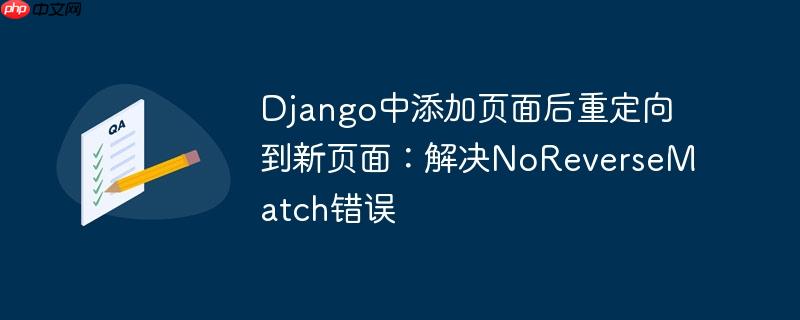
本文旨在解决 Django 开发中,使用 add_page 函数创建新页面后无法重定向到该页面,并出现 NoReverseMatch 错误的问题。通过分析错误原因,提供修改方案,并结合示例代码,帮助开发者理解 Django URL 反向解析机制,从而实现成功重定向。
NoReverseMatch 错误通常发生在 Django 试图根据 URL 的名称反向解析 URL 时,但无法找到匹配的 URL 模式。 在本例中,错误信息 "reverse for 'entry' not found. 'entry' is not a valid view function or pattern name." 表明 Django 无法找到名为 'entry' 的 URL 模式。
解决此问题的关键在于使用 reverse 函数正确生成 URL。 reverse 函数允许你根据 URL 模式的名称及其参数动态生成 URL。
步骤 1: 导入 reverse 函数
首先,需要在 views.py 文件中导入 reverse 函数:
from django.urls import reverse
步骤 2: 使用 reverse 函数进行重定向
然后,在 add_page 函数中使用 reverse 函数生成 'entry' URL,并将其传递给 redirect 函数:
def add_page(request):
form = AddPageForm()
if request.method == "POST":
form = AddPageForm(request.POST)
if form.is_valid():
title = form.cleaned_data['title']
content = form.cleaned_data['content']
entries = util.list_entries()
for entry in entries:
if title.upper() == entry.upper():
return render(request, "encyclopedia/error.html")
util.save_entry(title, content)
# 使用 reverse 函数生成 URL
return redirect(reverse('encyclopedia:entry', kwargs={'title': title}))
else:
return render(request, "encyclopedia/addpage.html", {
"form": AddPageForm()
})代码解释:
urls.py文件确认:
确保你的 urls.py 文件中,'entry' URL 模式的定义正确,并且指定了 name='entry'。
app_name = "encyclopedia"
urlpatterns = [
path("", views.index, name="index"),
path("entry/<str:title>/", views.entry, name="entry"),
path("search/", views.search, name="search"),
path("add_page", views.add_page, name="addpage"),
path("edit_page/<str:title>", views.edit_page, name="editpage"),
path("random_page/", views.random_page, name="random"),
]通过使用 reverse 函数,可以确保在 Django 中正确生成 URL,并避免 NoReverseMatch 错误。 记住,在使用 reverse 函数时,需要指定正确的 URL 模式名称及其参数。 正确理解和使用 Django 的 URL 反向解析机制对于构建健壮的 Web 应用程序至关重要。
以上就是Django中添加页面后重定向到新页面:解决NoReverseMatch错误的详细内容,更多请关注php中文网其它相关文章!

每个人都需要一台速度更快、更稳定的 PC。随着时间的推移,垃圾文件、旧注册表数据和不必要的后台进程会占用资源并降低性能。幸运的是,许多工具可以让 Windows 保持平稳运行。




Copyright 2014-2025 https://www.php.cn/ All Rights Reserved | php.cn | 湘ICP备2023035733号